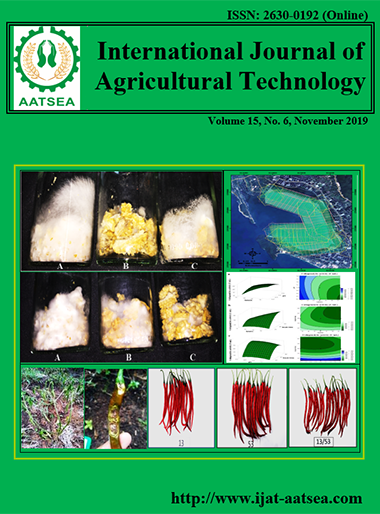Augmented analysis for yield and pod characteristics of yardlong bean (Vigna unguiculata (L.) Walp. ssp. sesquipedalis Verdc.) lines
Main Article Content
Abstract
The selected forty yardlong bean lines in the sixth generation (F6) of the cross between two parental cultivars were recorded to compare with four cultivars, viz. Bangpra Purple, Bangpra #2 (parental cultivars), Lamnamchee, and Tarnthong (commercial cultivars). The results showed that the forty lines significantly differed in pod length, number of seeds per pod (p<0.01), and yield per hectare (p<0.05). The means for pod length and yield of the lines were significantly higher than the control. Eight lines expressed the pod length ranging from 70.35 to 75.85 cm that are longer than the parent (69.50 cm of Bangpra #2) but not significantly different (p>0.05). Twenty-one lines possessed pod lengths from 61.41 to 75.85 cm that are significantly different (p>0.05) from the commercial cultivar (52.52 cm). The Bangpra #2 cultivar gave the significantly highest yield (19.16 t/ha) compared to the control. There were four promising lines for possessing yields ranging from 20.60 to 22.80 t/h and tended to get more value than the Bangpra #2 cultivar. Most of the selected F6-lines were proven to have better performance than the commercial cultivars, and some cultivars had better performance than their parents. Thus, these promising lines would be selected for yield trials in the next generation.
Article Details

This work is licensed under a Creative Commons Attribution-NonCommercial-NoDerivatives 4.0 International License.
References
Bos, I. (1983). Optimum number of replications when testing lines of families on a fixed number of plots. Euphytica, 32:311-318.
Department of Agricultural Extension. (2018). Information technology system for agricultural production. Retrived from http://production.doae.go.th/report/report_main2.php?report.
Federer, W. T. (1956). Augmented (or hoonuiaku) designs. Hawaiian Planters’ Record, 55:191-208.
Federer, W. T. (1961). Augmented designs with one-way elimination of heterogeneity. Biometrics, 17:447-473.
Federer, W. T. and Raghavarao, D. (1975). On augmented designs. Biometrics, 31:29-35.
Fehr, W. R. (1987). Principles of cultivar development. Vol. I. Theory and Techniques. Macmillan Publishing Company, N York, USA.
Gauch, H. G. and Zobel, R. W. (1996). Optimal replication in selection experiments. Crop Science, 36:838-843.
Kanhong, A. and Pornsuriya, P. (2014). Yield trial of 40 yard long bean lines. Khon Kaen Agriculture Journal, 42:634-640.
National Research Council (2006). Lost crops of Africa, Vol. II: Vegetables. The National Academies Press, Washington, DC.
Poehlman, J. M. and Sleper, D. A. (1995). Breeding field crops: Fourth Edition. Iowa State University Press, Ames.
Porcher, M. H. (2005). Sorting Vigna names. The University of Melbourne. Retrieved from http://www.plantnames.unimelb. edu.au/Sorting/Vigna.html. March 10, 2007.
Pornsuriya, P. and Pornsuriya, P. (2016). Variations of pod characters in F2 progenies of crosses between yardlong bean lines. VIIth Conference of Plant Genetic Conservation Project under the Royal Initiation of Her Royal Highness Princess Maha Chakri Sirindhorn (RSPG). Khon Kaen University, Khon Kaen.
Sarutayophat, T. and Nualsri, C. (2010). The efficiency of pedigree and single seed descent selections for yield improvement at generation 4 (F4) of two yardlong bean populations. Kasetsart Journal (Natural Science), 44:343-352.
Stephens, J. M. (2003). Bean, Yard-Long--Vigna unguiculata subsp. sesquipedalis (L.) Verdc. University of Florida IFAS Extension, Publication HS562. Retrieved from http://edis.ifas.ufl.edu/MV029.
United States Department of Agriculture (2007). Vigna unguiculata (L.) Walp. subsp. sesquipedalis (L.) Verdc. Retrieved from http://www.ars-grin.gov/cgi- in/npgs/html/taxon.pl?41646.


